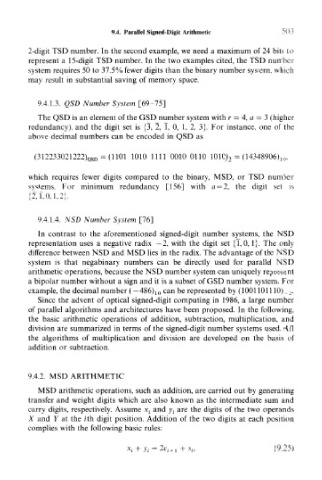Page 518 - Introduction to Information Optics
P. 518
9.4. Parallel Signed-Digit Arithmetic 503
2-digit TSD number. In the second example, we need a maximum of 24 bits to
represent a 15-digit TSD number. In the two examples cited, the TSD number
system requires 50 to 37.5% fewer digits than the binary number system, which
may result in substantial saving of memory space.
9.4.1.3. QSD Number System [69-75]
The QSD is an element of the GSD number system with r = 4, a = 3 (higher
redundancy), and the digit set is (3, 2, 1,0, 1, 2, 3}. For instance, one of the
above decimal numbers can be encoded in QSD as
(312233021222) QSD = (1101 1010 1111 00100110 1010) 2 = (14348906) 10,
which requires fewer digits compared to the binary, MSD, or TSD number
systems. For minimum redundancy [156] with a — 2, the digit set is
{2,1,0,1,2}.
9.4.1.4. NSD Number System [76]
In contrast to the aforementioned signed-digit number systems, the NSD
representation uses a negative radix —2, with the digit set {1,0,1). The only
difference between NSD and MSD lies in the radix. The advantage of the NSD
system is that negabinary numbers can be directly used for parallel NSD
arithmetic operations, because the NSD number system can uniquely represent
a bipolar number without a sign and it is a subset of GSD number system. For
example, the decimal number ( —486) 10 can be represented by (1001101110) ^_ 2 .
Since the advent of optical signed-digit computing in 1986, a large number
of parallel algorithms and architectures have been proposed. In the following,
the basic arithmetic operations of addition, subtraction, multiplication, and
division are summarized in terms of the signed-digit number systems used. All
the algorithms of multiplication and division are developed on the basis of
addition or subtraction.
9.4.2. MSD ARITHMETIC
MSD arithmetic operations, such as addition, are carried out by generating
transfer and weight digits which are also known as the intermediate sum and
carry digits, respectively. Assume x i and y { are the digits of the two operands
X and Y at the ith digit position. Addition of the two digits at each position
complies with the following basic rules:
(9.25)
x i + y i = 2c i+l +s h

